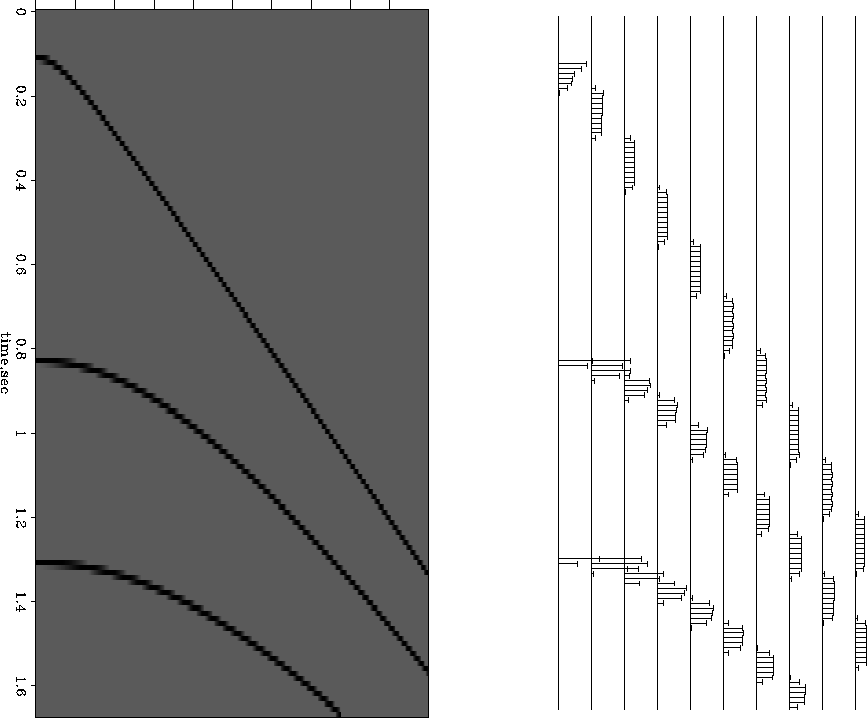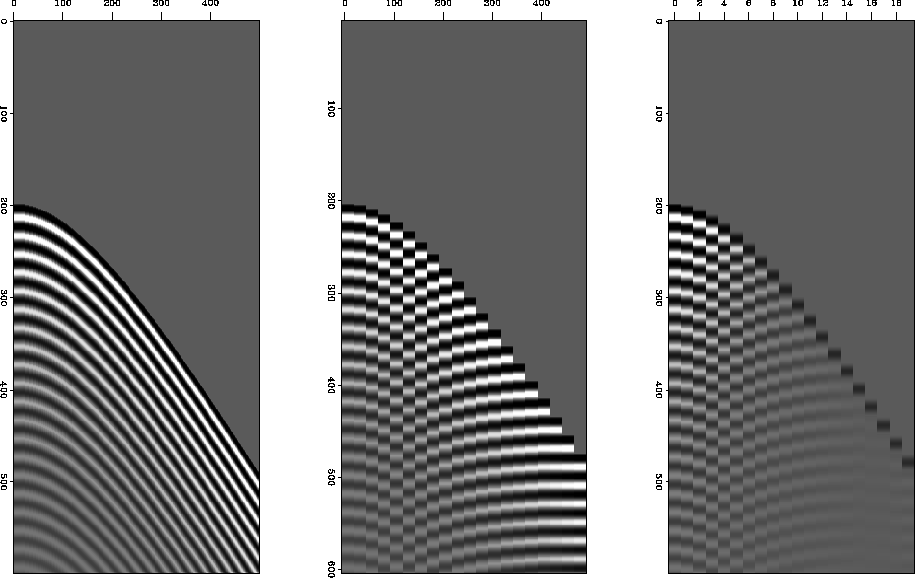In geophysical data recording there is usually
a local array whose elements are added locally
before a single channel is recorded.
For example, the SEP student group once laid out more than 4056 geophones
in a two-dimensional array of ![]() recorders
with 24 geophones added at each recorder.
We may think of the local superposition
as an integration over a small interval of space
to create a sampled space function from a continuous one.
With vibrator sources, it is also customary to vibrate on
various nearby source locations and sum them into a single signal.
Figure 2 is a caricature of what happens.
On the left a data field appears
to be a continuous function of space
(it is actually 500 spatial locations)
with various impulsive signals at different times and distances.
recorders
with 24 geophones added at each recorder.
We may think of the local superposition
as an integration over a small interval of space
to create a sampled space function from a continuous one.
With vibrator sources, it is also customary to vibrate on
various nearby source locations and sum them into a single signal.
Figure 2 is a caricature of what happens.
On the left a data field appears
to be a continuous function of space
(it is actually 500 spatial locations)
with various impulsive signals at different times and distances.
 |
Some of the rectangles are longer than others. The narrow ones are tall and the wide ones are short because the area of each rectangle must be 50 (being the sum of 50 channels each holding a 1). Since the rectangles all have the same area, were we to lowpass filter the sparse data we would recover the original characteristic that all these signals have the same amplitude.
Figure 3 shows a quasisinusoidal signal and compares subsampling to antialiasing via field arrays as in Figure 2.
 |
We see that aliased energy has been surpressed but not removed.
Let us see how we can understand the result
and how we could do better (but we won't).
Suppose that the 500 channels had been individually recorded.
The right panel in
Figure 3
was computed simply by adding in groups of 25.
A lengthier explanation of the calculation
is that the 500 channels were convolved along
the horizontal x-axis with a 25 point long rectangle function.
Then the 500 channel output was subsampled to 20 channels.
This lengthier calculation gives the same result
but has a simple Fourier explanation:
Convolving with a rectangle function of x
is the Fourier equivalent to multiplying by a sinc function
![]() in the Fourier domain.
We have convolved with a rectangle in the physical domain
which amounts to multiplication by a sinc function in the Fourier domain.
Theoretically we would prefer to have done it the other way around,
convolved with a sinc in the physical domain, equivalently
multiplying with a rectangle in the Fourier domain.
The Fourier rectangle would drop to zero at half Nyquist
and thus subsampling would not fold back any energy from
above the half Nyquist to below it.
Although Figure 3 shows that the aliased
information is strongly suppressed, you can see that it
has not been eliminated.
Had we instead convolved with a sinc on the x-axis,
the Fourier function would have been a rectangle.
You would see the wavefronts in
Figure 3 (right panel)
vanishing where the dip reached a critical threshhold
instead of seeing the wavefronts gradually tapering off
and weak aliased events still being visible.
in the Fourier domain.
We have convolved with a rectangle in the physical domain
which amounts to multiplication by a sinc function in the Fourier domain.
Theoretically we would prefer to have done it the other way around,
convolved with a sinc in the physical domain, equivalently
multiplying with a rectangle in the Fourier domain.
The Fourier rectangle would drop to zero at half Nyquist
and thus subsampling would not fold back any energy from
above the half Nyquist to below it.
Although Figure 3 shows that the aliased
information is strongly suppressed, you can see that it
has not been eliminated.
Had we instead convolved with a sinc on the x-axis,
the Fourier function would have been a rectangle.
You would see the wavefronts in
Figure 3 (right panel)
vanishing where the dip reached a critical threshhold
instead of seeing the wavefronts gradually tapering off
and weak aliased events still being visible.